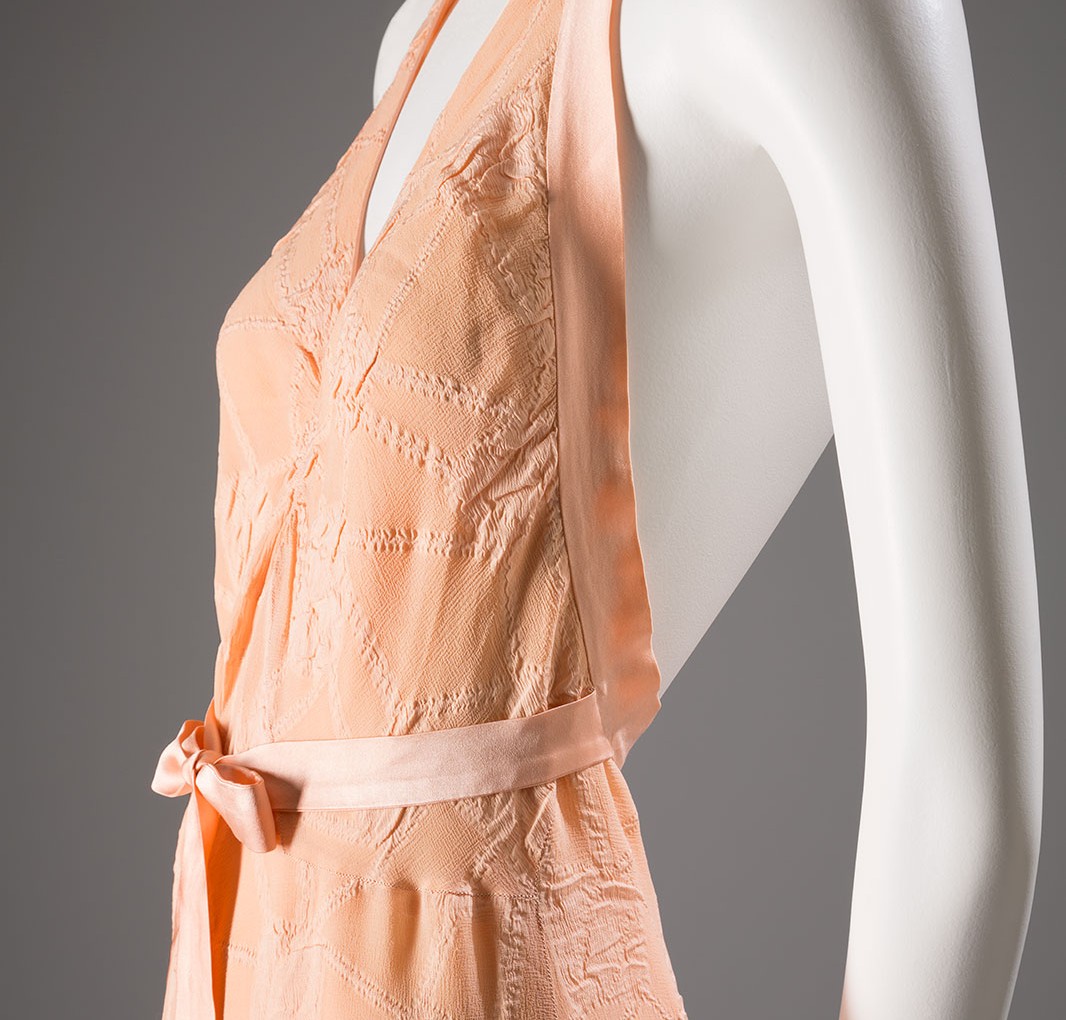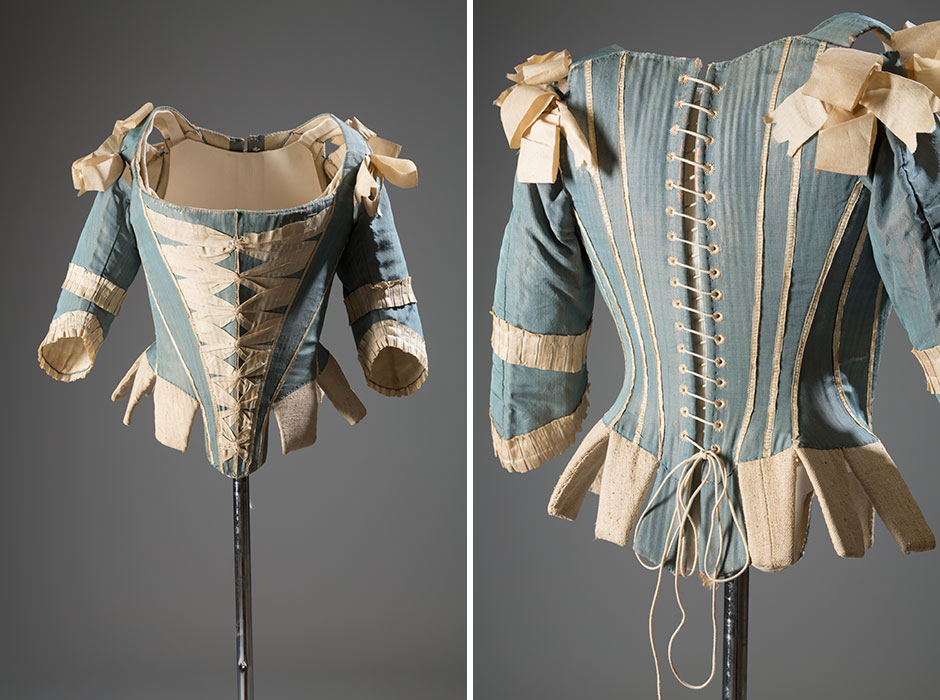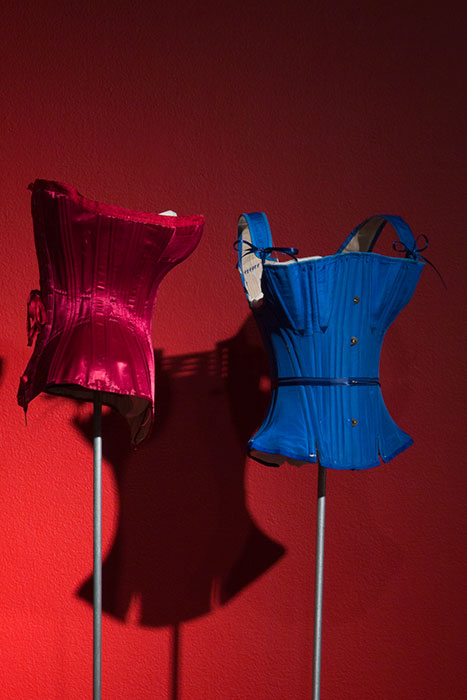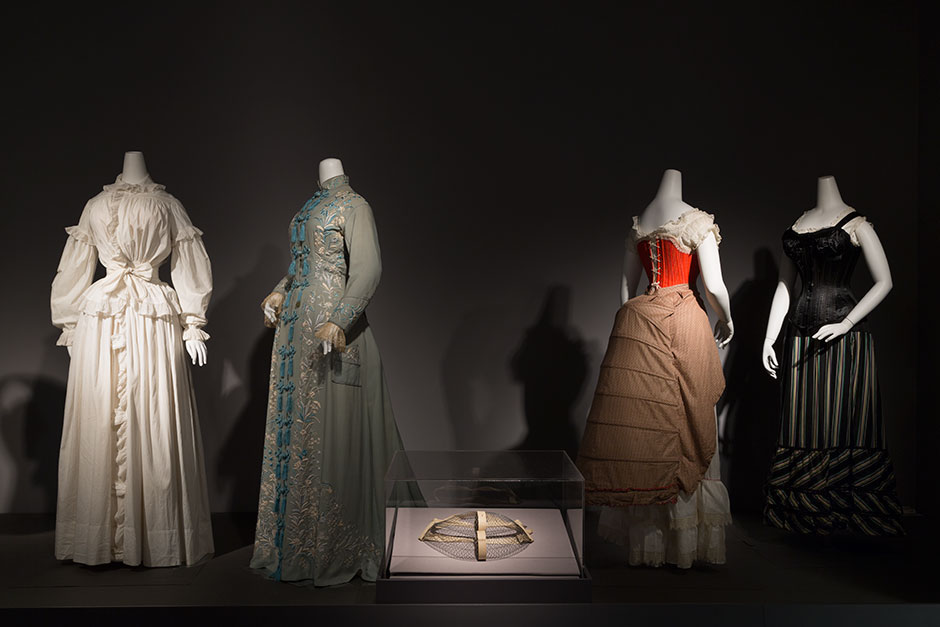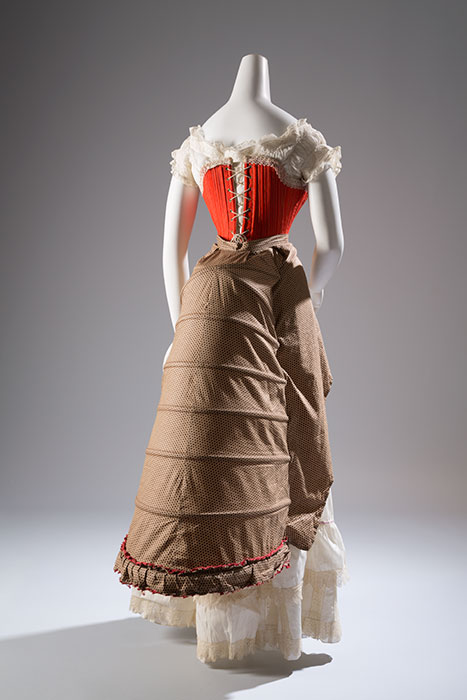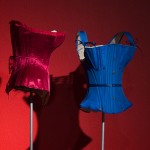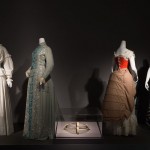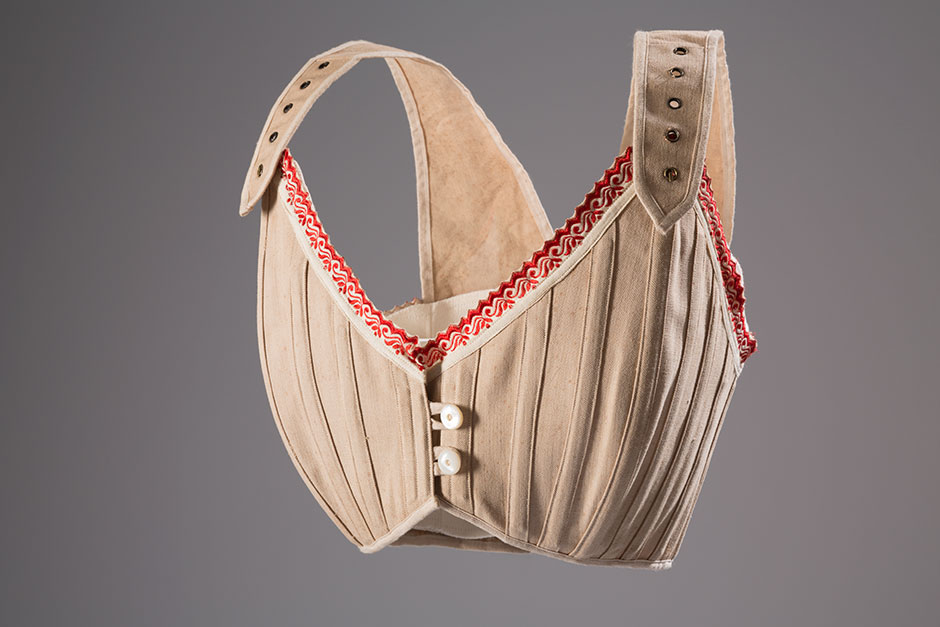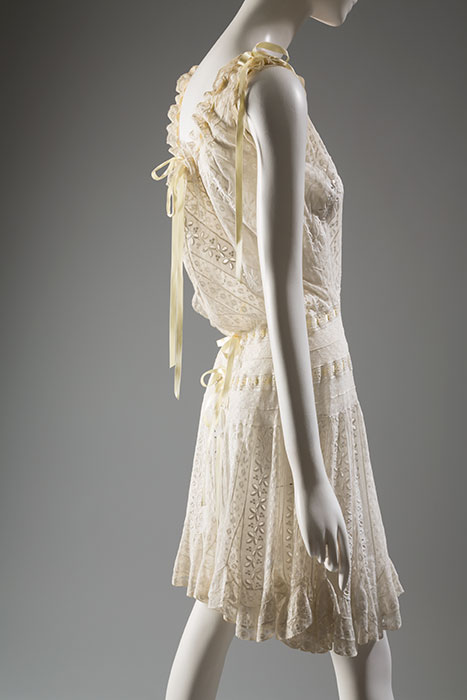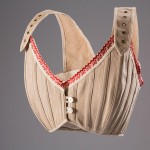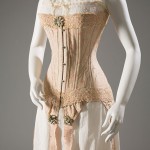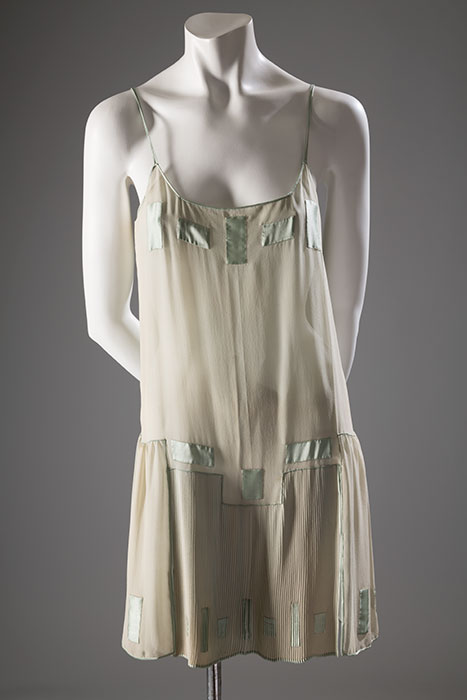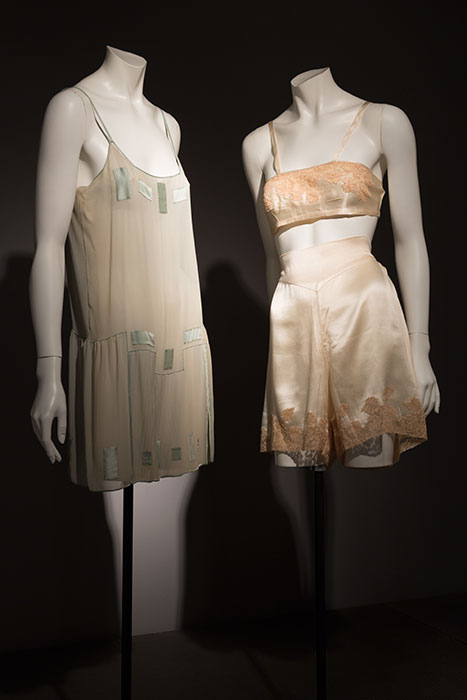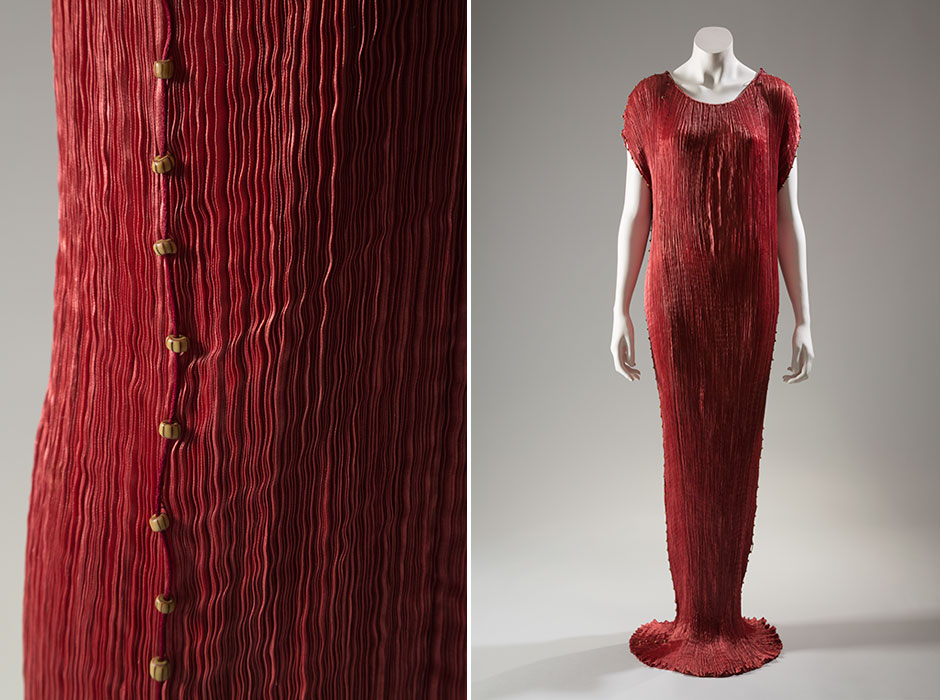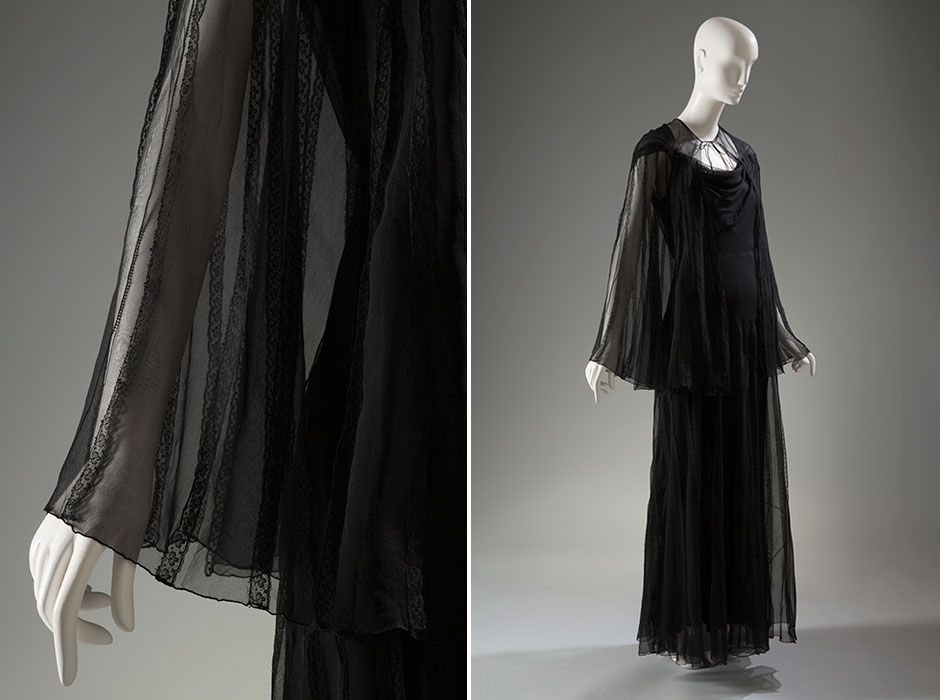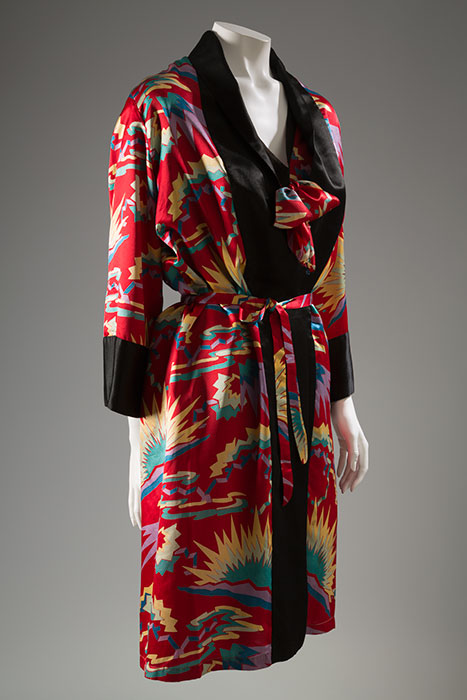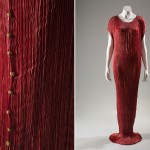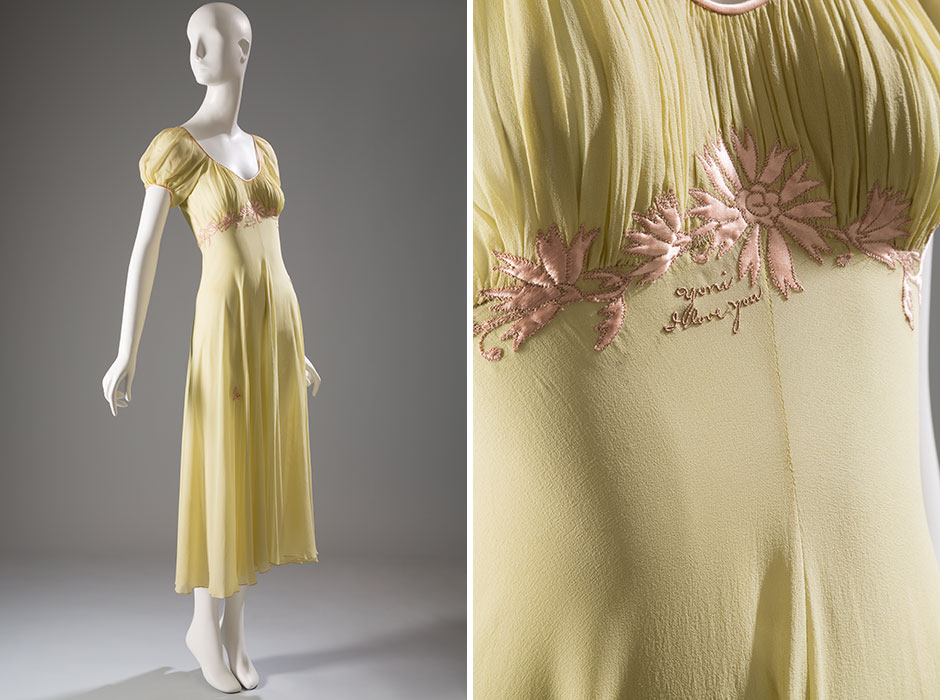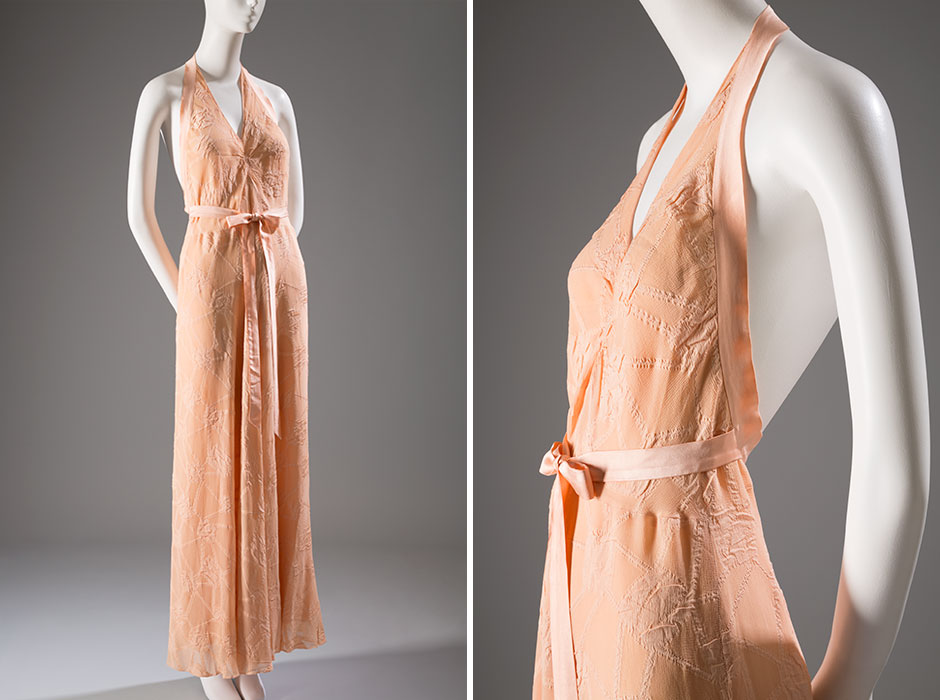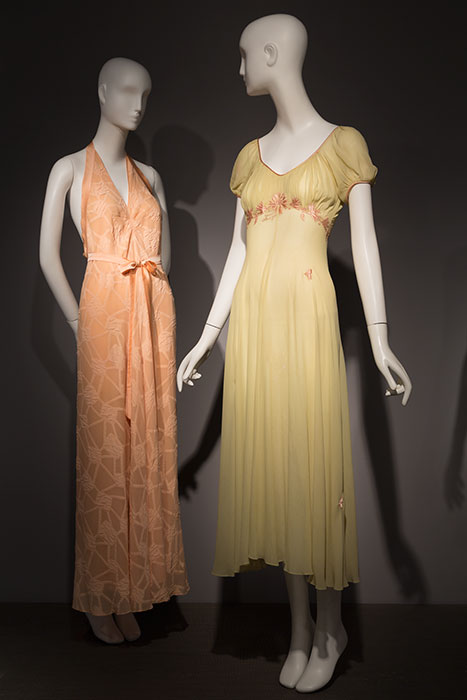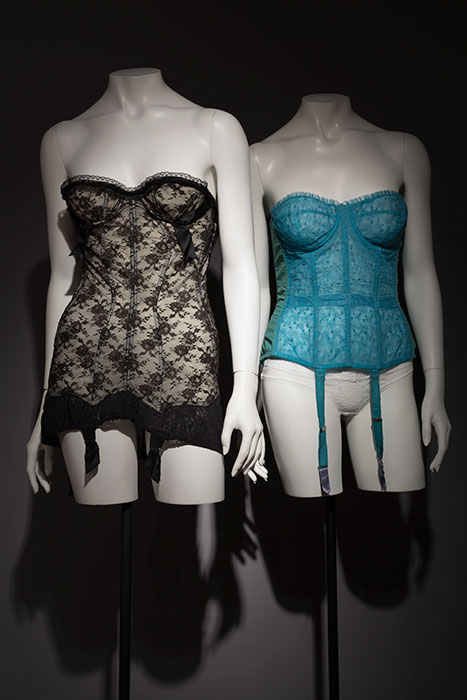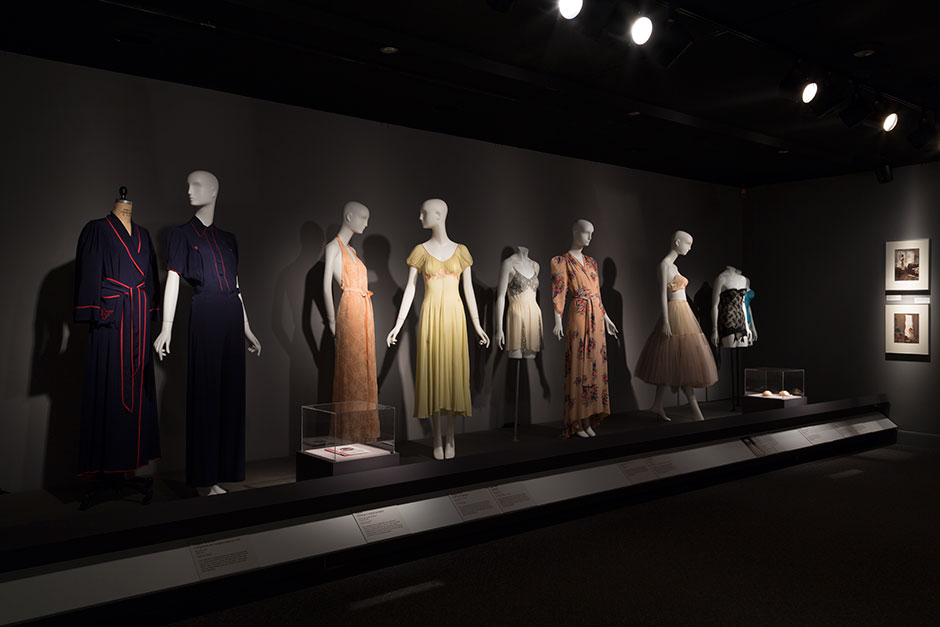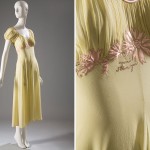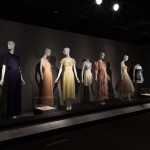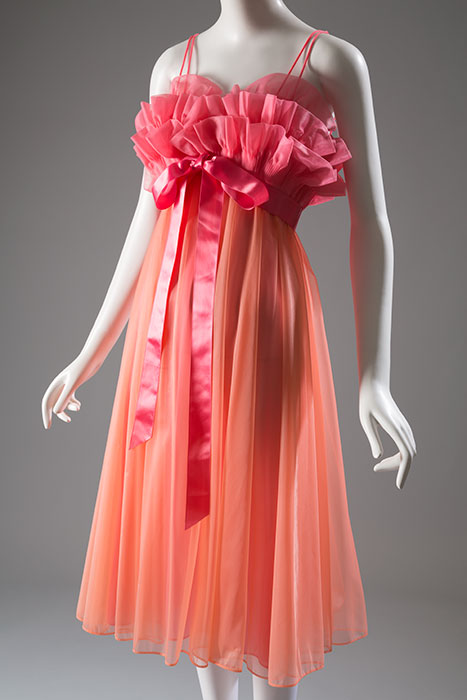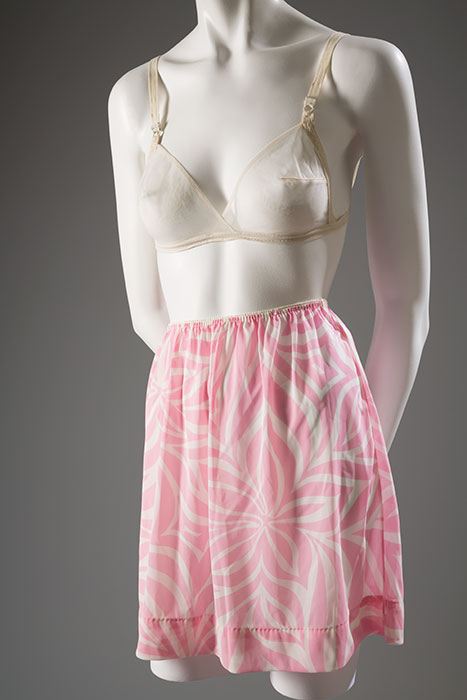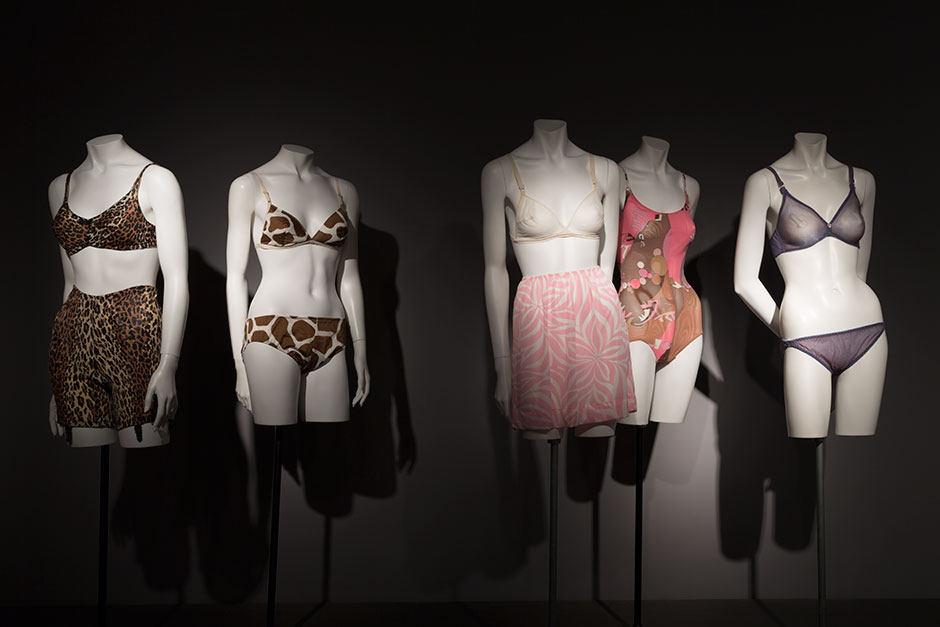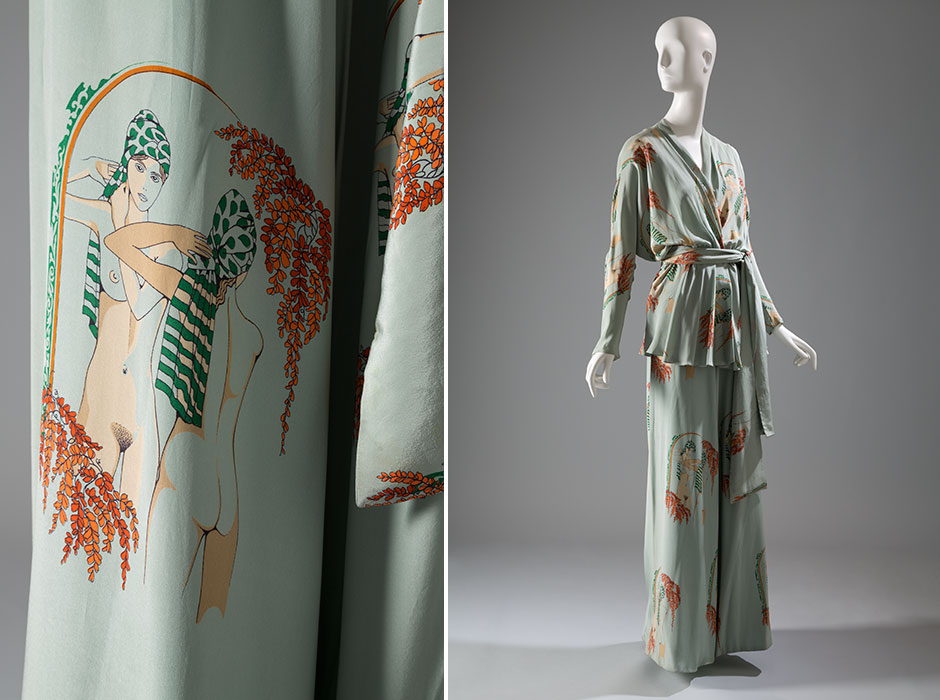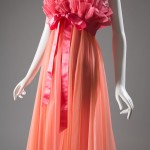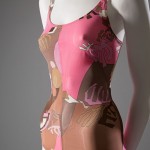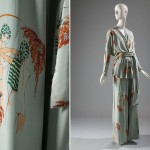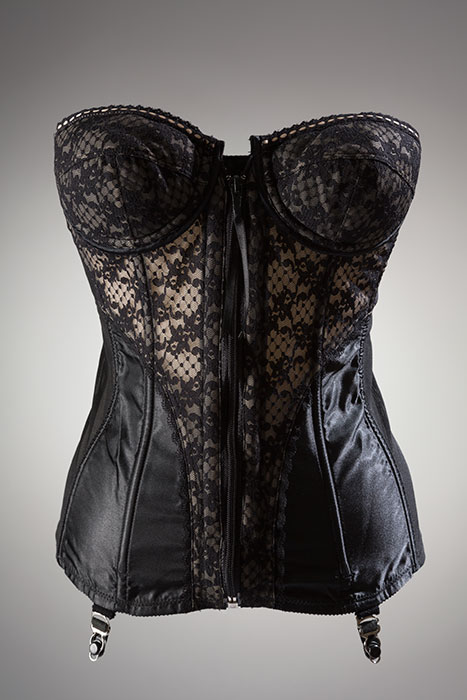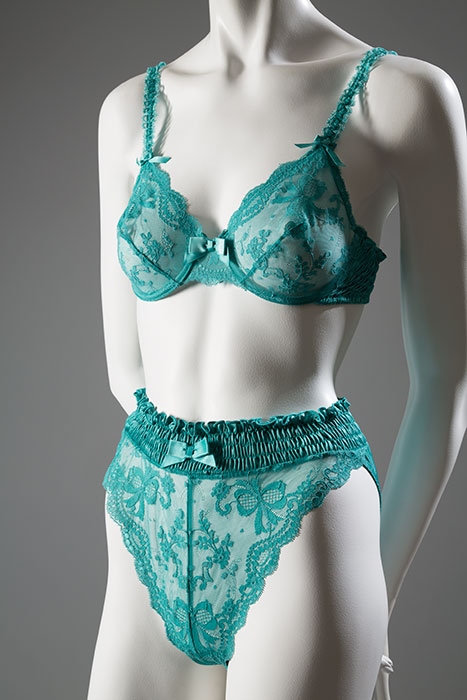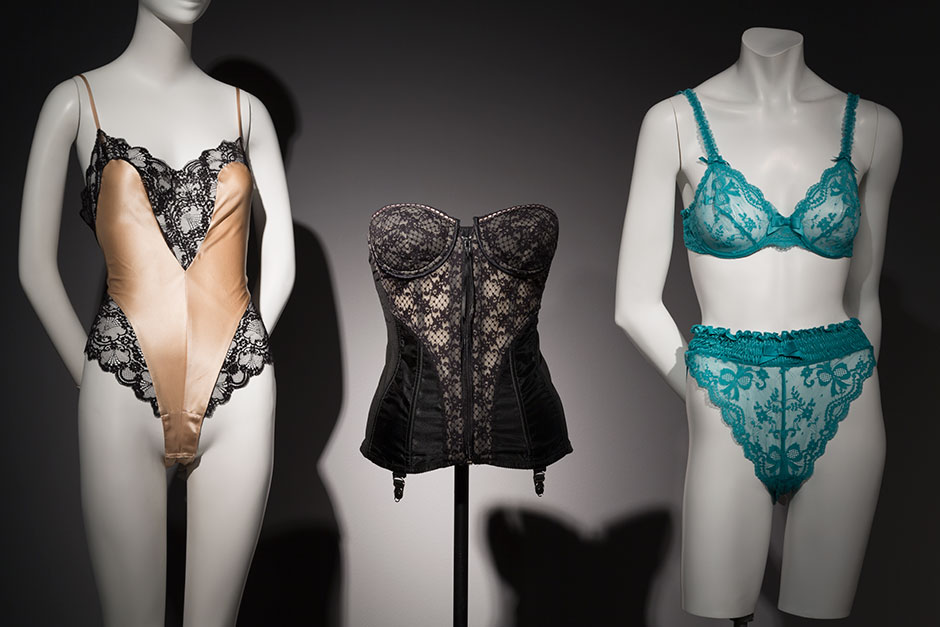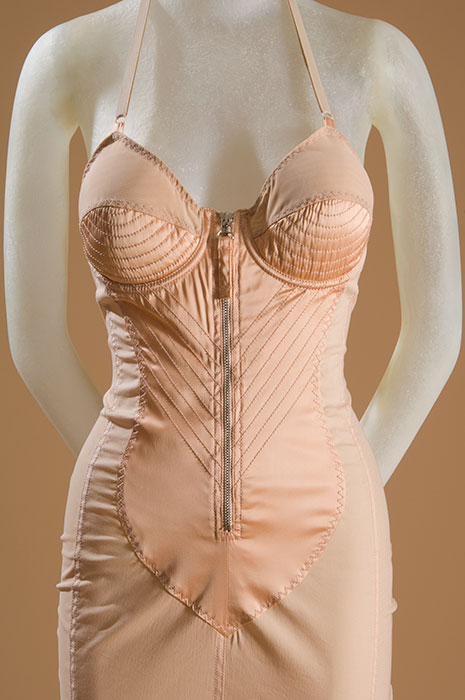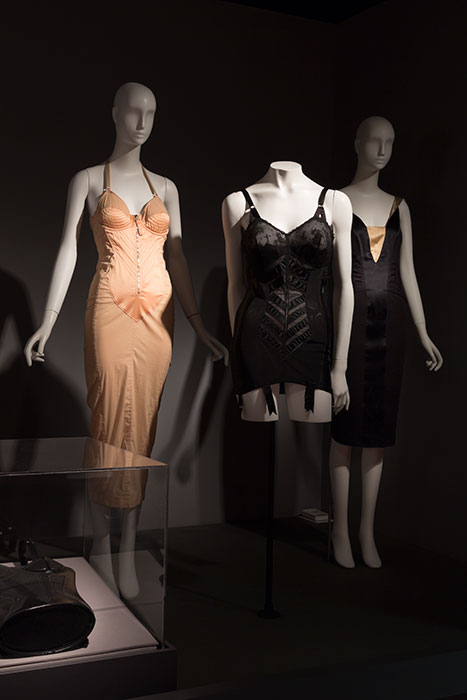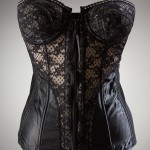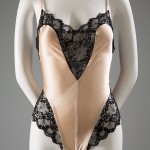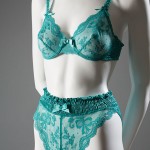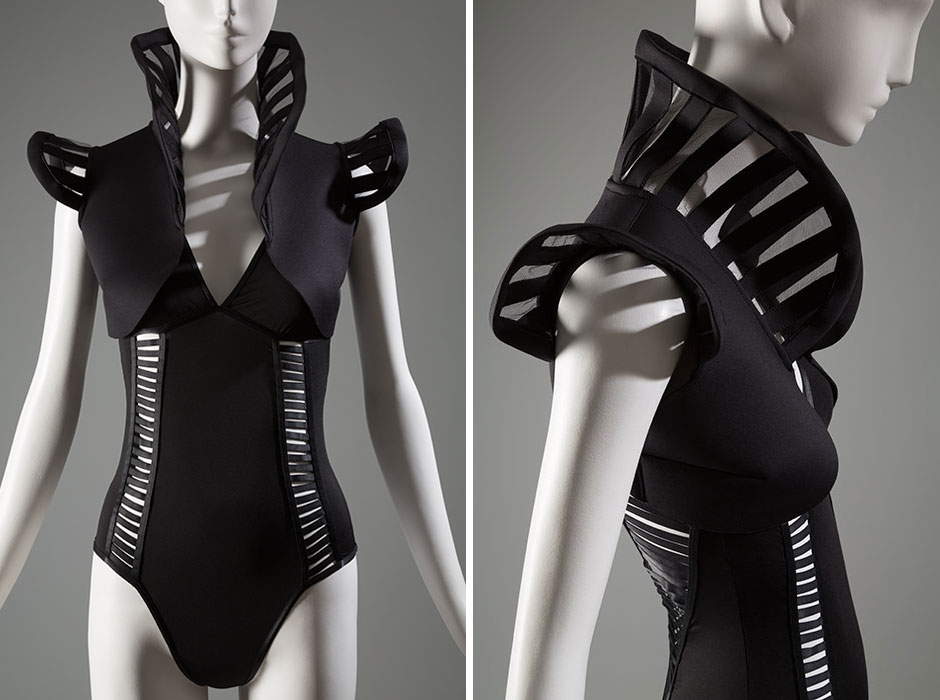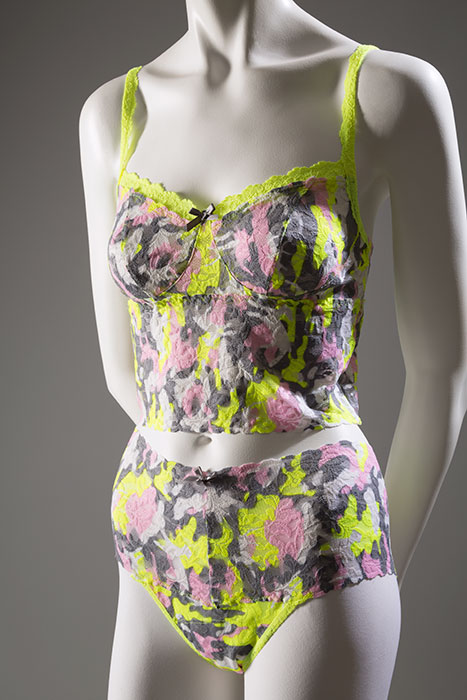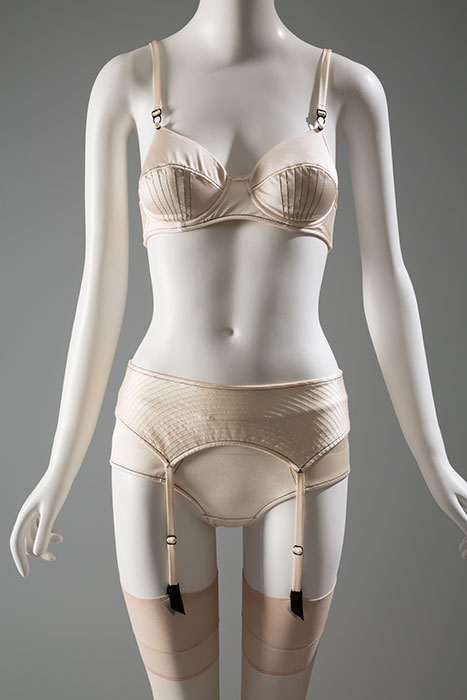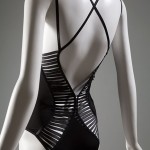18th & 19th Centuries
As the relationship between dress and the body has been redefined over time, so too have the function and appearance of lingerie. During the eighteenth century, some decorative corsets and petticoats were worn as part of a woman’s dress. Many modestly designed nineteenth century undergarments were viewed strictly within intimate settings. Yet in 1898, a “mania” for elaborate, colorful, and seductive lingerie led French journalist Octave Uzanne to lament that “the last remains of feminine modesty sunk out of sight.”
-
Image InfoClose
Corset (stays)
Stays were obligatory for the “strait-laced” woman of the eighteenth century. Although they were associated with respectability and high social status, stays also held an erotic allure. In France, the toilette—a semipublic ritual of dressing and undressing—included the subtheme of putting on a corset. Stays with sleeves are rare, and may indicate that this corset was part of an at-home ensemble.
Light blue silk, silk ribbon, whalebone, circa 1770, USA, P82.1.16, museum purchase
-
Image InfoClose
Quilted petticoats functioned as both underclothing and outer garments during the eighteenth century. Some women’s gowns were made with skirts that opened in front, revealing petticoats that complemented dress fabrics. Different petticoats could be mixed and matched with the same gown, changing the look of the ensemble without necessitating the purchase of a new dress.
An 1811 fashion article described “a short corset, fitted exactly to the natural shape” as the ideal style to wear beneath the high-waisted, “Grecian” gowns of the early nineteenth century. This example emphasizes the bust using contoured cups that lift the breasts, as well as a center front busk that separates and defines them.
Center: Quilted petticoat, ivory silk satin, circa 1765, England, P78.3.1, museum purchase
Right: Corset, light brown cotton sateen, circa 1815, England, 2009.1.1, museum purchase
-
Image InfoClose
Corsets were an essential element of women’s fashion for about 400 years—from the late Renaissance through the early twentieth century. Although corsets were constricting, they were essential to achieving the fashionable silhouette. Corsets were also positively identified with qualities such as self-discipline, social status, and beauty.
Most corsets were white until the 1880s, when color started to become fashionable. Although the vibrant red corset is especially alluring, it was likely marketed as a “healthy” style. Its curvaceous silhouette was achieved using Coraline, a plant-based material marketed as a more flexible alternative to whalebone or steel.
Left: Warner Bros. corset, red silk satin, Coraline, circa 1889, USA, 2009.15.2, museum purchase
Right: Corset, blue silk, circa 1850, USA, 2014.4.1, museum purchase
-
Image InfoClose
Installation view
-
Image InfoClose
Dressing gowns were specialized garments worn before a woman dressed. Many styles were modestly designed from plain white fabrics with subtle trimming. Although dressing gowns were only worn in privacy, they usually followed the fashionable silhouette. This example features the full sleeves and smocked waist seen on dresses from the early 1840s.
Peignoirs (taken from the French peigner, to comb) were alternately known as combing dresses, wrappers, and morning robes. They were designed for women to wear in their own homes, offering them a reprieve from corsets. While earlier peignoirs often emphasized practicality over prettiness, this design exemplifies a late 19th-century shift toward more lavish intimate apparel.
Left: Dressing gown, white cotton, lace, circa 1840, USA, U.862, museum purchase
Right: Peignoir, light green embroidered wool, circa 1878, USA, 80.1.5, gift of Florence Anderson and Mary A. Seymour
-
Image InfoClose
Corset & bustle
The bustle evolved from the crinoline during the late 1860s. It took many forms over the next twenty years, but all bustles were designed to emphasize the posterior. The more extreme bustle styles, such as those from the early 1880s, were often more elaborately structured. This example—a hybrid of a bustle and a petticoat—was sometimes referred to as a “crinolette.”
Corset: Red wool, silk, steel, whalebone, circa 1880, possibly France, 98.29.3, museum purchase
Bustle: Polka dot printed cotton, steel, circa 1880, USA, P83.29.1, museum purchase
-
Image InfoClose
The M.A. Spencer Company corset & striped petticoat
Black corsets contrasted with the prevailing fashion for white styles during the nineteenth century. Widows often wore black corsets as part of their mourning costumes, but black was also a fashion color. Women were advised to wear dark underwear under any dress made from black fabric.
Fashionable women wore layers of petticoats, many of which were made from plain white fabrics. Brightly colored petticoats began to appear during the 1860s, as synthetic dyes became widespread. These vivid styles were often worn over more subdued examples, since the topmost petticoat might be glimpsed at the hem of the wearer’s skirt as she moved.
The M. A. Spencer Company corset: black silk satin, circa 1898, USA, P91.69.1, museum purchase
Petticoat: striped polished cotton, circa 1890, USA, 82.34.6, gift of Cora Ginsburg
1900-1919
By 1908, Vogue‘s correspondent in Paris wrote that “The petticoat is obsolete, pre-historic.”
-
Image InfoClose
Bust supporter
Bust supporters and proto-brassieres re-emerged as the fashionable silhouette changed during the late nineteenth century. They were able to lift and enhance the breasts in ways that were not possible with traditional corsetry. While bust supporters took a variety of forms, this example would have helped to create the fashionable “monobosom” silhouette of the early twentieth century.
Natural linen, cotton trim, circa 1905, France, 98.29.5, museum purchase
-
Image InfoClose
Stockings
Stockings of the late nineteenth and early twentieth centuries were often elaborately designed, and featured elements such as patterning, decorative insets, and embroidered motifs over the feet and calves. Red was an especially fashionable color.
Silk, circa 1900, France, 76.64.1, gift of Mrs. W. R. Hearst, Jr.
-
Image InfoClose
Corset & chemise
Early twentieth-century corsets rested low on the bosom, and extended over the hips. When laced, the so-called “straight-front” corset provided an “S curve” that pushed the breasts forward, pressed in the stomach, and arched the back. Although visually alluring (and pioneered by female corsetières), this corset style was highly constricting.
Corset: Floral brocaded silk, silk ribbon, elastic, circa 1905, England, 98.37.1, museum purchase
Chemise (slip): White cotton, silk ribbon, circa 1905, USA, 2012.53.2, gift of Leigh Bantivoglio
-
Image InfoClose
Fernande Burel tea gown
The tea gown developed during the late nineteenth century when 5 o’clock tea became fashionable. Loose-fitting and usually worn without a corset, tea gowns were strictly for at-home wear during the early 20th century. As they could be worn to receive visitors, many were crafted from opulent materials. This example was worn by Lulu Glaser, a prominent American actress and singer.
Carnation-printed silk chiffon, silk, lace, circa 1900, France, 2003.12.1, museum purchase
-
Image InfoClose
Combination
Undergarments became increasingly streamlined during the late 19th century. Combinations, which joined a camisole and drawers into a single garment, were especially prevalent. The desire to eliminate layers of undergarments corresponded to the slimmer dress silhouette of the Edwardian era.
Cotton eyelet lace, silk ribbon, circa 1900, USA, U.131, origin unknown
-
Image InfoClose
Nightgown
This delicate, revealing nightgown was made by a mother for her daughter’s trousseau. A bridal trousseau consisted of many items—from housewares and linens to outerwear—but lingerie was an especially crucial component. If a bride made her selections well, she would not need to purchase new underclothes for several years.
Cotton, bobbin lace, silk ribbon, 1907, USA, 82.91.1, gift of Catherine B. Canda
-
Image InfoClose
Strouse, Adler Company corset
Prominent couturiers such as Paul Poiret and Madeleine Vionnet began to design corset-less clothing styles during the early 20th century, but many women continued to wear corsets. By the early 1920s, comfort and modernity had become crucial to corset design. Many corsets (now also called girdles) had elastic panels that allowed for greater freedom of movement.
Brocaded satin, elastic, ribbon, circa 1920, USA, 85.80.21, gift of the Strouse, Adler Company
-
Image InfoClose
Tea gown
This tea gown is trimmed with thick bands of mink, exemplifying the increasingly opulent design of interior garments during the early decades of the twentieth century. In 1922, etiquette expert Emily Post described the tea gown as “a hybrid between a wrapper and a ball dress.”
Silk chiffon, lace, mink, silk flowers, velvet ribbons, circa 1918, USA, 90.180.4, gift of Ms. Elizabeth Roberts
-
Image InfoClose
Installation view
1920s & 1930s
Modernism in fashion highlighted the “natural” and classically idealized body. In place of the more voluminous and restrictive styles of the Edwardian era, fashion became softer and sleeker.
-
Image InfoClose
Saks Fifth Avenue Camiknickers
Camiknickers evolved from the combination garments of the early 20th century. Beginning in the late 1910s, camiknickers were made from light, delicate fabrics that facilitated a lean silhouette. By the 1920s, drawers had narrowed and shortened, resulting in a sleek new style that could be worn under the tubular, knee-length dresses of the era.
Crepe chiffon, silk satin, circa 1924, France, P86.63.5, museum purchase
-
Image InfoClose
Bra and panties
Bras had become essential to many women’s wardrobes by the late 1920s. The simple silhouettes of both bras and panties allowed them to be easily produced, resulting in what French novelist Louis-Ferdinand Céline called “a new period of democratically available fine underwear.” Silk undergarments in pastel hues were especially favored.
Right: Cream silk satin, beige lace, 1928, USA, 2001.42.2A-B, gift of Ruth Jaffe
-
Image InfoClose
Fortuny Delphos tea gown
Fortuny’s Delphos gown, inspired by drapery from ancient Greek sculpture, is crafted from finely-pleated silk that skims the wearer’s body. Intended to be worn without a corset, the Delphos was first used as a tea gown.
Pleated silk, glass beads, circa 1925, Italy, 85.193.5, gift of Mrs. Varney T. Elliot and Mrs. Rosemary T. Franciscus
-
Image InfoClose
Suzanne Bertillon ensemble: hostess gown and slip
Garments intended to be worn at home, such as hostess gowns, were frequently imaginative in design. The outer gown of this ensemble is constructed from a single length of fabric, with a hole cut in the center for the wearer’s head. The gold griffon motif is meticulously hand-stamped onto the silk voile.
Painted silk voile, silk, lace, metallic gold pigment, circa 1922, France, P82.18.3, museum purchase
-
Image InfoClose
Cadolle corselet & bra and briefs
Clothing of the 1930s required a slender yet womanly silhouette. Many women relied on all-in-one girdles, also called corselets, that supported the breasts, cinched the waist, and smoothed the hips. This example also has an attached skirt that acts as a slip. These streamlined, one-piece garments were especially recommended for wear under evening dresses.
Most bras of the 1930s were made with two distinct cups, to accommodate the fashionable figure of the time, which was slim yet shapely. While this example has no inner structure, its seamed construction defines the shape of the breasts. Drawers had begun their transformation into shorter, more fitted styles during the 1920s, but they became even sparer during the 1930s—and were aptly called “briefs.”
Left: Cadolle corselet, satin, lace, elastic, circa 1933, France, 89.94.6, gift of Mrs. Bartle Bull
Right: Bra, silk charmeuse, circa 1930, USA, 2012.53.6, gift of Leigh Bantivoglio
Briefs, rayon knit, circa 1935, USA, 79.72.11, gift of Renee Gladstein -
Image InfoClose
Bergdorf Goodman Negligée set: gown and cape
Negligées are lounging or sleeping ensembles that are characterized by diaphanous fabrics. This example from Bergdorf Goodman follows the silhouette of many late 1930s evening gowns, which were fitted at the waist and had long, flaring skirts. Bergdorf’s opened an elegant new space devoted to lingerie, called the “Salone Intime,” in 1935.
Chiffon, lace, circa 1938, USA, 88.27.2, gift of Ron Leal
-
Image InfoClose
Lounging set: robe and matching blouse
It is likely that this robe and blouse were originally part of a set of lounging pajamas. First seen in the pages of Vogue during the 1910s, many lounging pajamas showed influence from Asia and the Near East. They often featured loose tunics or kimono-style tops over wide-legged trousers.
Silk, circa 1930, probably USA, 90.190.20, gift of Elinor Toberoff
-
Image InfoClose
Regine Brenner Loungewear set: lounging pajamas, robe
The loosely-fitted lounging pajamas of the 1920s had evolved into more smartly tailored styles by the end of the late 1930s. This set was part of a trousseau, and the robe features the bride’s new initials—DGZ—embroidered on the right pocket. It was custom made by Regine Brenner, who ran a boutique on New York’s Upper West Side.
Silk crepe, satin, 1939, USA, 96.89.6, gift of Mrs. Doris Goldsmith
1940s & 1950s
In 1939, L’Officiel published lingerie designs by leading couturiers, noting the clean lines and cuts that allowed for freedom of movement. By the 1950s, the look of sleepwear began to directly influence fashion. Conversely, Dior’s New Look of 1947 brought back the hyper-feminine, hourglass figure, created by “waspy” girdles and layers of petticoats.
-
Image InfoClose
Poirette overwire bra & Christian Dior petticoat
Christian Dior’s 1947 “New Look” collection heralded a return to the hourglass silhouette. The bust became a focal point, and its shape was defined by a variety of highly structured bras and corselets. Petticoats were often worn to maintain skirt fullness. This petticoat by Dior was made especially for one of his couture gowns.
Poirette overwire bra: nylon lace, stretch satin, 1949, USA, 2000.89.15, gift of Bestform Inc.
Christian Dior petticoat: nylon net, horsehair net, silk taffeta, 1951, France, 75.86.5B, gift of Despina Messinesi
-
Image InfoClose
Juel Park Nightgown
Couture lingerie designer Juel Park made Grace Kelly’s trousseau, and fashioned lingerie for Marlene Dietrich, Marilyn Monroe, and Elizabeth Taylor—among many others. She began her business in Hollywood in 1929. Park’s meticulous hand-craftsmanship—as well as her store’s prime Hollywood location—ensured her success with an especially elite clientele.
Silk crepe chiffon, circa 1945, USA, 2009.66.11, gift of Christina Orr-Cahall in honor of Anona Boben
-
Image InfoClose
Maggy Rouff Halter-neck nightgown
Halter-neck gowns became fashionable during the 1930s. Although a revealing neckline was most commonly used for evening dresses and swimsuits, it was also well-suited to intimate apparel. The intricately woven silk used to make this example has a “patchwork” pattern, providing texture and visual interest without interrupting the gown’s streamlined silhouette.
Novelty woven silk, silk satin, 1940, France, 82.151.61, gift of Mrs. Jefferson Patterson
-
Image InfoClose
Installation view
-
Image InfoClose
The look of 1950s sleepwear directly influenced fashion. Claire McCardell was one of the first fashion designers to adopt the nylon fabrics typically used in lingerie and sleepwear.
Upscale lingerie brand Iris specialized in wispy nightgowns and slips that were simply but elegantly designed. Printed floral fabrics had long been used for lingerie, but they were especially prevalent during the early 1950s.
Left: Claire McCardell evening gown, printed nylon, 1950, USA, 72.61.182, gift of Mr. and Mrs. Adrian McCardell
Right: Iris nightgown, printed nylon, circa 1950, USA, 75.183.80, gift of Mrs. A. S. Guimares
-
Image InfoClose
“Emphasis is being placed on the small, nipped-in waistline, as the important feature for this fall’s foundation silhouette,” reported the New York Times in 1951. “The general contour is one of rounded, easy feminine lines with no angles.” Strapless corselets were ideal for wear beneath evening gowns, and underwire cups lifted and emphasized the breasts.
Warner’s line of “Merry Widow” foundation garments was inspired by the 1952 movie of the same name, which featured Lana Turner wearing an elaborate, long-line corset. While Warner’s Merry Widows changed in style over the course of the 1950s, all were intended to reduce the measurement of the waist significantly.
Left: Marie-Rose Lebigot for Lily of France corselet ,lace, nylon, elastic, circa 1954, USA, 82.155.8, gift of Mr. Robert Kaye
Right: Warner’s “Merry Widow” corset, embroidered nylon, elastic, circa 1957, USA, 81.24.32, gift of Mrs. Sally Iselin
-
Image InfoClose
Installation view
1960s & 1970s
By the 1960s, the pendulum had swung back to a girlish look with mini-skirts and colorful tights (no more garter-belts and stockings). “Fun” lingerie (now often referred to as “undies”) included matching sets of bras and panties in playful patterns such as animal prints.
-
Image InfoClose
Vanity Fair “Baby doll” nightgown
Actress Carroll Baker wore a hip-length, ruffled nightie and matching pantalets in the 1956 movie Baby Doll. The movie helped to popularize short, billowing sleepwear styles. Vanity Fair was known for its fashionable and brilliantly colored nylon sleepwear, which was both inexpensive and easy to care for.
Nylon tricot, circa 1960, USA, 87.82.5, gift of Dorothy Pollack
-
Image InfoClose
Clothing styles of the 1960s were more abbreviated than those of the previous decade. A trim, youthful figure was the ideal, but this shape was often achieved through diet and exercise rather than rigid corsetry. Less structured bras allowed the breasts to take a more natural shape, while smoothing panty girdles were worn beneath clothes that were moving ever closer to the body.
Many of Rudi Gernreich’s designs liberated women’s bodies from constricting garments. During the 1960s, he created bras for Exquisite Form that were constructed from mere triangles of stretchy fabric. This giraffe-print set matched a tunic and wide-legged trousers, underscoring Gernreich’s interest in “total look” dressing.
Left: Vanity Fair bra and panty girdle, leopard print nylon and elastic, circa 1962, USA, 75.183.69, gift of Mrs. A. S. Guimares
Right: Rudi Gernreich for Exquisite Form bra and panty, printed polyester tricot, 1967, USA, 82.135.148, gift of Mitch Rein
-
Image InfoClose
Rudi Gernreich for Exquisite Form “No-Bra” and half-slip
Rudi Gernreich’s provocative “no-bra” bra was a wireless, padding-free style that adapted to the natural shape of the breasts. It was available in numerous shades of sheer nylon that were intended to blend in with the wearer’s skin. The especially short hemline of Gernreich’s half-slip was ideal for wear beneath miniskirts.
Sheer white nylon, pink and white printed nylon, circa 1965, USA, 82.153.116 and 82.153.137 ,gifts of Mitch Rein
-
Image InfoClose
Emilio Pucci for Formfit Rogers Body stocking
Emilio Pucci designed for lingerie brand Formfit Rogers during the late 1960s and early 1970s, lending his colorful, boldly printed fabrics to everything from slips to lounging robes. The low-cut back, highcut briefs, and seamless fit of this body stocking ensured that it was nearly undetectable beneath revealing clothing styles.
Printed Lycra/Spandex blend, 1969, Italy, 87.82.20, gift of Dorothy Pollack
-
Image InfoClose
Shelly Easy Rider bra and panties
In 1972, Vogue described a lingerie set similar to this as “practically nothing to wear under everything.” While sheer fabrics and uninhibiting construction were carryovers from the previous decade, 1970s panties were cut higher on the leg and lower on the waist, resulting in a more pronounced “bikini” style.
Sheer nylon, circa 1977, South Africa, 2000.89.19, gift of Bestform, Inc.
-
Image InfoClose
Installation view
-
Image InfoClose
Valerie Porr lounging pajamas
The silhouette of these lounging pajamas was inspired by the 1930s, but the printed silk was decidedly of-the-moment. From the late 1960s through the mid-1970s, emphasis on all things “natural,” including the bare body, was often manifested in revealing clothing styles—but it was also referenced in other ways, such as the motif of a nude woman on this fabric.
Printed silk, 1976, USA, 99.14.3, gift of Valerie Porr
-
Image InfoClose
Fernando Sanchez dressing gown
Vogue announced the “start of lingerie fever” in 1978, describing a trend for luxurious intimate apparel led by designers such as Fernando Sanchez, whose sensuous lingerie could be worn multiple ways. This gown’s soft construction and lightweight fabric made it ideal for lounging, but the cutaway hemline and metallic threads were also suitable for evening wear.
Chiffon with multicolor metallic pinstripes, 1982, USA, 83.128.1, gift of Fernando Sanchez
-
Image InfoClose
Installation view
1980s & 1990s
Throughout all the vicissitudes of fashionable lingerie from the 1980s to the present–from the Wonderbra to the thong–one thing remained constant: lingerie was perceived as an exceptionally erotic category of women’s fashion.
-
Image InfoClose
Lady Marlene bustier
The bustier—an abbreviated, modernized version of the corset—was especially fashionable during the 1980s. This example is lightly boned over the front of the torso, but relies primarily on a stretch knit fabric for a snug fit. The resulting style highlights and contains the body’s curves, rather than aggressively molding them.
Jersey, lace, satin, circa 1988, USA, 93.159.65, gift of Ady Gluck-Frankel
-
Image InfoClose
Patricia Fieldwalker teddy
Teddies were derived from the combination undergarments of the early 20th century. By the 1980s, they had become especially provocative. In 1988, Intimate Fashion News reported that designers continued to “tempt the consumer to add more styles to her teddy wardrobe,” describing styles with “briefly cut silhouettes . . . high-cut legs and revealing spaghetti-strap bodices.”
Silk charmeuse, lace, circa 1988, USA, 2012.53.7, gift of Leigh Bantivoglio
-
Image InfoClose
Victoria’s Secret bra and panties
Victoria’s Secret was founded as a mail-order catalog in 1977, corresponding to renewed interest in ultra-feminine lingerie styles. Now a household name, the brand specializes in designs that are stylish and sexy, yet accessible. Brightly colored fabrics, such as the teal lace used for this set, have become a hallmark of the Victoria’s Secret style.
Lace, 1990, USA, 90.161.3, gift of Victoria’s Secret
-
Image InfoClose
Installation view
-
Image InfoClose
Moschino evening dress
Moschino took the concept of underwear as outwear to a playful new extreme, fashioning this dress from twenty black lace bras. The bras’ molded cups provide the skirt with texture and volume, while the dangling straps create an unusual and provocative fringe.
Rayon, underwire brassieres, Spring 1994, Italy, 94.106.1, gift of Moschino
-
Image InfoClose
Jean Paul Gaultier “Girdle” dress
Jean Paul Gaultier’s interest in lingerie can be traced back to his childhood, when he discovered his grandmother’s corset. “From that moment I became fascinated by the idea of transforming one’s body with clothes,” he recalled. Gaultier’s body-conscious dresses, inspired by girdles and corsets, helped to ignite a trend for underwear-as-outerwear during the 1980s.
Peach cotton/nylon blend, peach satin, circa 1987, France, 98.98.1, museum purchase
-
Image InfoClose
Installation view
2000s – now
The exhibition concludes with an array of contemporary lingerie, from the stylish comfort of Hanky Panky to the overt eroticism of Agent Provocateur.
-
Image InfoClose
Suki Cohen (Sarah Cohen) Bodysuit
Stretch nylon, 2014, Colombia, 2014.11.1, gift of Suki Cohen
-
Image InfoClose
Suki Cohen (Sarah Cohen) bodysuit and bolero jacket
Sarah Cohen’s dynamic collection of lingerie blurs the lines between underwear and outerwear. While her bodysuits act as foundation garments, they are also designed to be seen. Cohen eschews delicate materials and pastels for black stretch fabrics, and highlights the body using cutouts. She describes her technique as “dealing with different tensions—like engineering for clothing.”
Stretch nylon and neoprene, 2014, Colombia, 2014.11.1-.2, gift of Suki Cohen
-
Image InfoClose
“The concept of the visible corset has become a socially acceptable form of erotic display,” wrote fashion historian Valerie Steele in her 2001 book, The Corset: A Cultural History. This example by Cadolle was designed as outerwear, but it can also be worn as lingerie. The choice of bright pink lace is overtly—and unapologetically—girlish.
Cadolle’s delicate nightgown offers a contemporary variation on the feminine “baby doll” styles of the 1950s. Herminie Cadolle founded her namesake lingerie line in 1889, and was known for her early, innovative brassiere designs. The company remains in the Cadolle family, and is one of only a few brands that continue to produce made-to-order lingerie.
Left: Cadolle Malia corset, chantilly lace, cotton, Spring 2007, 2014.10.1, gift of Cadolle Paris
Right: Cadolle Kyo nightgown, silk, 2008, France, 2014.10.2, gift of Cadolle Paris
-
Image InfoClose
Agent Provocateur Aliyah lingerie ensemble: bra, thong, and suspenders
“The British have gone lingerie crazy,” reported Women’s Wear Daily in 1996, due in no small part to the opening of the first Agent Provocateur boutique in London two years earlier. Selling whips and pasties alongside bras and panties, the label helped to spark a trend for high-end, overtly erotic lingerie that continues today.
Leopard print stretch polyester, black ribbon, 2008, England, 2008.88.1, museum purchase
-
Image InfoClose
Designs by Chantal Thomass often possess what she calls the “over/under” quality—items that function as underwear, but are also beautiful enough to be worn as integral parts of an outerwear ensemble. Thomass began designing lingerie in 1975, when she audaciously offered romantic, nostalgic designs that opposed the prevailing style for practical undergarments.
Founded in 1876, Chantelle offers proof that French lingerie has never lost its cachet. The company specializes in lingerie that is sexy and beautifully made, but also suitable for everyday wear. This classic bra and panty set is meticulously crafted from two patterns of black lace, and edged with an especially fine, scalloped lace trim.
Left: Chantal Thomass ensemble: bra, panties, and suspenders, stretch knit, Fall 2013, France, 2014.7.2, gift of Chantelle Paris
Right: Chantelle bra and panties, stretch knit, lace, Fall 2013, France, 2014.7.1, gift of Chantelle Paris
-
Image InfoClose
L.A.M.B. x Hanky Panky Lambie Camo Retro Cropped Cami and Lambie Camo Retro Thong
This camisole and panty set is part of a collaboration between Hanky Panky and Gwen Stefani’s fashion brand, L.A.M.B. The fluorescent camouflage print reveals influence from street fashion— an important element of Stefani’s creations. The set’s retro styling underscores both Stefani’s and Hanky Panky’s appreciation for vintage clothing and lingerie.
Stretch lace, Fall 2014, USA, 2014.9.1-.2, gift of Hanky Panky Ltd.
-
Image InfoClose
La Perla bra and panties
La Perla, meaning “pearl” in Italian, was founded by skilled corsetière Ada Masotti in 1954. Masotti presented her early designs in velvet-lined boxes, as if they were pieces of jewelry. Now one of the most coveted high-end lingerie brands, La Perla is especially known for its luxurious fabrics, such as the finely embroidered net used for this ensemble.
Embroidered tulle, silk, stretch silk satin, 2014, Italy, 2014.12.1, gift of La Perla
-
Image InfoClose
Installation view
-
Image InfoClose
Jean Yu bra and panties
Jean Yu’s meticulous, made-to-measure lingerie relies on traditional craftsmanship, but her designs are distinctly contemporary. Yu uses no underwire or padding, and eschews surface decoration. Elements such as grosgrain ribbon become integral to her garments’ construction. While gauzy fabrics and revealing cuts convey a sense of femininity and fragility, the garments’ clean lines are almost stark in their simplicity.
Silk chiffon, grosgrain ribbon, Spring 2005, 2005.55.1, gift of Jean Yu
-
Image InfoClose
A.F. Vandervorst Ensemble: bra, panties, suspenders, stockings
This ensemble was part of the first lingerie collection by Belgian brand A.F. Vandervorst. The label’s designers, Filip Arickx and An Vandervorst, based their designs on their studies of traditional French corsetry. The lingerie was shown on the runway alongside their outerwear creations—many of which also showed influence from classic lingerie styling.
Stretch silk, nylon/spandex, 2006, Belgium, Nightfall collection, 2006.42.1, gift of A.F. Vandervorst

